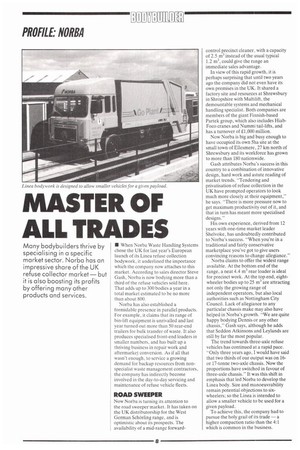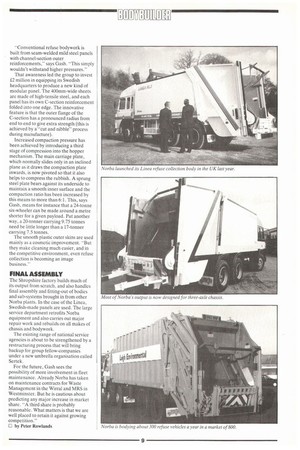MASTER OF ALL TRADES
Page 148

Page 149

If you've noticed an error in this article please click here to report it so we can fix it.
Many bodybuilders thrive by specialising in a specific market sector. Norba has an impressive share of the UK refuse collector market— but it is also boosting its profits by offering many other products and services,
IN When Norba Waste Handling Systems chose the UK for last year's European launch of its Linea refuse collection bodywork, it underlined the importance which the company now attaches to this market. According to sales director Steve Gash, Norha is now bodying more than a third of the refuse vehicles sold here. That adds up to 300 bodies a year in a total market estimated to be no more than about 800.
Norba has also established a formidable presence in parallel products. For example, it claims that its range of bin-lift equipment is unrivalled and last year turned out more than 50 rear-end trailers for bulk transfer of waste. It also produces specialised front-end loaders in smaller numbers, and has built up a thriving business in repair work and aftermarket conversion. As if all that wasn't enough, to service a growing demand for backup resources from nonspecialist waste management contractors, the company has indirectly become involved in the day-to-day servicing and maintenance of refuse vehicle fleets.
ROAD SWEEPER
Now Norba is turning its attention to the road sweeper market. It has taken on the UK distributorship for the West German Schorling range, and is optimistic about its prospects. The availability of a mid-range forward
control precinct cleaner, with a capacity of 2.5 m3 instead of the usual typical 1.2 m3, could give the range an immediate sales advantage.
In view of this rapid growth, it is perhaps surprising that until two years ago the company did not even have its own premises in the UK. It shared a factory site and resources at Shrewsbury in Shropshire with Multilift, the demountable systems and mechanical handling specialist. Both companies are members of the giant Finnish-based Partek group, which also includes HiabFoco cranes and Nummi tail-lifts, and has a turnover of £1,000 million.
Now Norba is big and busy enough to have occupied its own 5ha site at the small town of Ellesmere, 27 km north of Shrewsbury and its workforce has grown to more than 180 nationwide.
Gash attributes Norba's success in this country to a combination of innovative design, hard work and astute reading of market trends. "Tendering and privatisation of refuse collection in the UK have prompted operators to look much more closely at their equipment," he says. "There is more pressure now to get maximum productivity out of it, and that in turn has meant more specialised designs."
His own experience, derived from 12 years with one-time market leader Shelvoke, has undoubtedly contributed to Norba's success. "When you're in a traditional and fairly conservative marketplace you've got to give users convincing reasons to change allegiance."
Norba claims to offer the widest range available. At the bottom end of the range, a neat 4.4 m3 rear loader is ideal for precinct work. At the top end, eightwheeler bodies up to 25 m3 are attracting not only the growing range of independent operators, but also local authorities such as Nottingham City Council. Lack of allegiance to any particular chassis make may also have helped in Norba's growth. "We are quite happy bodying Dennis or any other chassis," Gash says, although he adds that Seddon Atkinsons and Leylands are still by far the most popular.
The trend towards three-axle refuse vehicles has continued at a rapid pace. "Only three years ago, I would have said that two thirds of our output was on 16or 17-tonne two-axle chassis. Now the proportions have switched in favour of three-axle chassis." It was this shift in emphasis that led Norba to develop the Linea body. Size and manoeuvrability remain potential objections to sixwheelers; so the Linea is intended to allow a smaller vehicle to be used for a given payload.
To achieve this, the company had to pursue the holy grail of its trade — a higher compaction ratio than the 4:1 which is common in the business. "Conventional refuse bodywork is built from seam-welded mild steel panels with channel-section outer reinforcements," says Gash. "This simply wouldn't withstand higher pressures."
That awareness led the group to invest £2 million in equipping its Swedish headquarters to produce a new kind of modular panel. The 400mm-wide sheets are made of high-tensile steel, and each panel has its own C-section reinforcement folded into one edge. The innovative feature is that the outer flange of the C-section has a pronounced radius from end to end to give extra strength (this is achieved by a—cut and nibble" process during manufacture).
Increased compaction pressure has been achieved by introducing a third stage of compression into the hopper mechanism. The main carriage plate, which normally slides only in an inclined plane as it draws the compaction plate inwards, is now pivoted so that it also helps to compress the rubbish. A sprung steel plate bears against its underside to maintain a smooth inner surface and the compaction ratio has been increased by this means to more than 6:1. This, says Gash, means for instance that a 24-tonne six-wheeler can be made around a metre shorter for a given payload. Put another way, a 20-tonner carrying 9.75 tonnes need be little longer than a 17-tonner carrying 7.5 tonnes.
The smooth plastic outer skins are used mainly as a cosmetic improvement. "But they make cleaning much easier, and in the competitive environment, even refuse collection is becoming an image business."
FINAL ASSEMBLY
The Shropshire factory builds much of its output from scratch, and also handles final assembly and fitting-out of bodies and sub-systems brought in from other Norba plants. In the case of the Linea, Swedish-made panels are used. The large service department retrofits Norba equipment and also carries out major repair work and rebuilds on all makes of chassis and bodywork.
The existing range of national service agencies is about to be strengthened by a restructuring process that will bring backup for group fellow-companies under a new umbrella organisation called Sertek.
For the future, Gash sees the possibility of more involvement in fleet maintenance. Already Norba has taken on maintenance contracts for Waste Management in the Wirral and MRS in Westminster. But he is cautious about predicting any major increase in market share. "A third share is probably reasonable. What matters is that we are well placed to retain it against growing competition."
0 by Peter Rowlands
















































































































































































